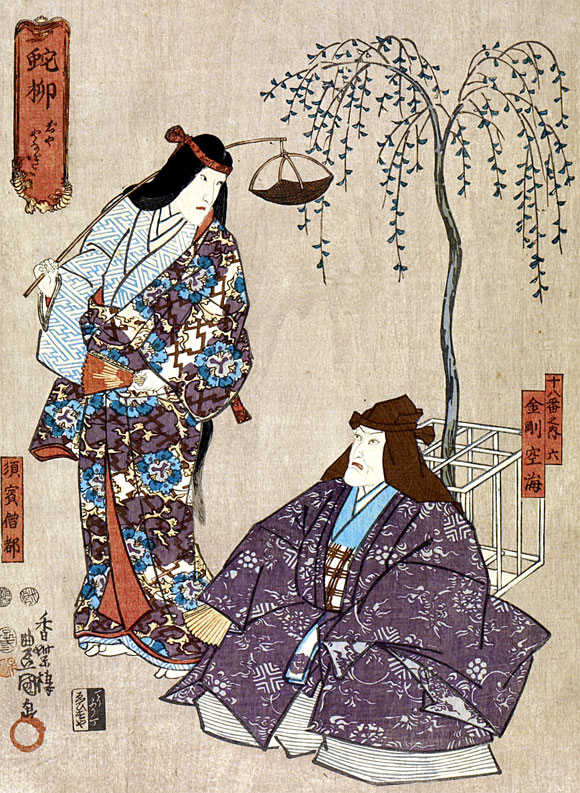| JAYANAGI |
| Play titles | K˘yasan Jayanagi Momo Chidori ďiso Gayoi |
| Common title | Jayanagi |
| Authors | Kawajiri Seitan (1947) Matsuoka Ry˘ (2010) |
| History |
"Jayanagi" was premiered in the 5th lunar month of 1763 at the Nakamuraza. It was entitled "K˘yasan Jayanagi" and it was staged within the new year drama "Momo Chidori ďiso Gayoi". The leading role of the bakamono Tanba no Suketar˘, later the spirit of the Snake Willow was played by Ichikawa Danjűr˘ IV [picture]. The originality of this drama was the unusual mixing of aragoto with shittogoto. It went to oblivion and the original script was lost but it was nevertheless added to the Kabuki Jűhachiban collection of drama in 1840 by Ichikawa Ebiz˘ V. It was revived in May 1947 at the T˘ky˘ Gekij˘ with a new script written by Kawajiri Seitan and starring Ichikawa Sansh˘ V in the leading role of Akushichiby˘e Kagekiyo [more details]. This version was a kagekiyomono, which was not the case in 1763. Never performed by either Ichikawa Danjűr˘ XI or Ichikawa Danjűr˘ XII, "Jayanagi" was finally revived by Ichikawa Ebiz˘ XI as a dance-drama written by Matsuoka Ry˘ and choreographed by Fujima Kanjűr˘ VIII. This revival was initially scheduled to be staged in January 2011 at the Theatre Ginza in T˘ky˘ but, following Ichikawa Ebiz˘'s pathetic drunken brawl in November 2010, it was cancelled. It was staged for the first time in August 2013 for the first edition of the ABKAI - Ebikai, the gala of the young star Ichikawa Ebiz˘, at the Shibuya Bunkamura Theatre Cocoon in T˘ky˘. This revival was quite successful and it was staged for the first time in Grand Kabuki, in T˘ky˘ at the Kabukiza in May 2015, using the same script [more details]. In 2013 and 2015, an oshimodoshi grand final was added at the end of the dance-drama. |
| Key words |
Aragoto Bakamono Jayanagi Kabuki Jűhachiban K˘yasan Kűkai Ky˘ran Oshimodoshi ďzatsuma Shittogoto Tanba |
| Summary |
The scene opens in sacred K˘yasan. A mysterious and beautiful jayanagi (Snake Willow) is set on stage. According to the legend, the priest Kűkai turned a maleficent giant snake into a weeping willow. This evil snake, which was terrorizing the area, was in fact a monster carrying the jealousy of all the women who had been abandoned by their husbands in order to become monks on the male-only K˘yasan. As a result of this miracle, the jayanagi is said to represent a thousand year bond between men and women. We are at the Oku-no-In cemetery in K˘yasan near the Snake Willow. The rumor says that this foul tree is causing harm to the people of this area. The priest J˘ken has been called to subdue it with his religious powers. Near the tree is the bakamono Tanba no Suketar˘ (Suketar˘ from the Tanba province). He tells the story of his recently deceased wife to whom he is still obsessively attached. Dancing his love for his late wife, he lapses into frenzy. This ky˘ran is the highlight of the play. Before long, it becomes obvious that Suketar˘ is possessed by the Spirit of the Snake Willow. This evil spirit aggressively attacks the priest J˘ken. At last, the powerful warrior Kong˘maru Terutada appears on the hanamichi. He is the demon-queller (oshimodoshi) and he has the power to save J˘ken and drive back the spirit. The spirit of the Snake Willow is subdued and Kong˘maru Terutada strikes a mie at the end this play. This summary would have not been possible without the help of AndrÚ! |
 |
|
The actors Ichikawa Danjűr˘ VIII (top/left) and Ichikawa Ebiz˘ V (bottom/right) playing the roles of Suh˘ S˘zu and Kong˘ Kűkai in the drama "Jayanagi" in a mitate-e print made in 1852 by Utagawa Toyokuni III |
|
|
| Contact | Main | Top | Updates | Actors | Plays | Playwrights | Programs | Links | FAQ | Glossary | Chronology | Illustrations | Prints | Characters | Derivatives | Theaters | Coming soon | News |